brake fluid OLDSMOBILE SILHOUETTE 1997 Owners Manual
[x] Cancel search | Manufacturer: OLDSMOBILE, Model Year: 1997, Model line: SILHOUETTE, Model: OLDSMOBILE SILHOUETTE 1997Pages: 436, PDF Size: 21.87 MB
Page 89 of 436
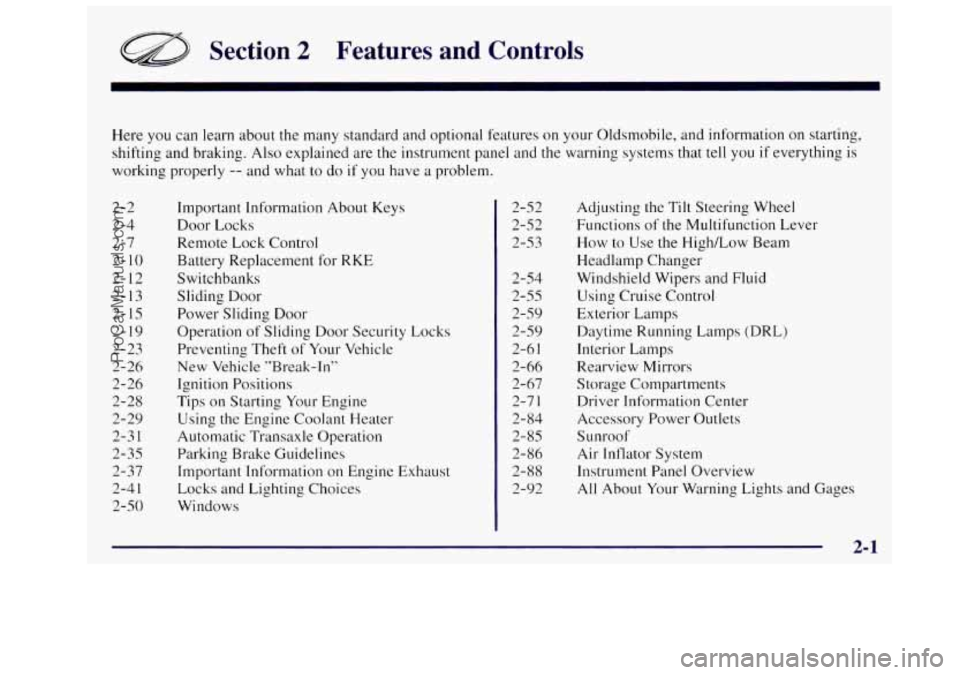
Section 2 Features and Controls
Here you can learn about the many standard and optional features on your Oldsmobile, and information on starting,
shifting and braking. Also explained are the instrument panel and the warning systems that
tell you if everything is
working properly
-- and what to do if you have a problem.
2-2 2-4
2-7
2-
10
2- 12
2-13 2-15
2-19
2-23
2-26 2-26
2-28 2-29
2-3 1
2-35
2-37
2-4
1
2-50 Important Information About Keys
Door Locks
Remote Lock
Control
Battery Replacement for RKE
Switchbanks
Sliding Door
Power Sliding Door
Operation of Sliding Door Security Locks
Preventing Theft
of Your Vehicle
New Vehicle "Break-In"
Ignition Positions
Tips on Starting
Your Engine
Using the Engine Coolant Heater
Automatic Transaxle Operation
Parking Brake Guidelines
Important Information on Engine Exhaust
Locks and Lighting Choices
Windows 2-52
2-52
2-53
2-54
2-55
2-59
2-59
2-6
I
2-66
2- 67
2-7
I
2- 84
2-85
2- 86
2-88
2-92 Adjusting the
Tilt Steering
Wheel
Functions of the Multifunction Lever
How to Use
the High/Low Beam
Headlamp Changer
Windshield Wipers and Fluid
Using Cruise Control
Exterior Lamps
Daytime Running Lamps (DRL)
Interior Lamps
Rearview Mirrors
Storage Compartments
Driver Information Center
Accessory Power Outlets
S u nroo f
Air Inflator System
Instrument Panel Overview
All About Your Warning Lights and Gages
ProCarManuals.com
Page 143 of 436

Rear Window Wiper and Washer
\-
I The rear window wiper
switch
is located in
the Instrument Panel
switchbank.
Push the wiper symbol on the bottom
of the button to
turn on the intermittent wiper. To turn off the wiper,
gently push the top
of the button.
To wash and wipe the rear window, push in the washer
symbol on the top
of the button. Washer fluid will spray
as long as the button is held
in. When the top of the
button is released, the wiper will continue to cycle three
more times.
To wash the rear window when the rear wiper is already on,
push on the top
of the button with the wash symbol on it.
Push in the bottom of the button to continue the intermittent
wiper cycle after the washing cycle is completed.
Cruise Control (Option)
With cruise control, you can maintain a speed of about
25 mph (40 km/h) or more without keeping your foot
on the accelerator. This can really help
on long trips.
Cruise control does not work at speeds below about
25 mph (40 kmh).
When you apply your brakes,
the cruise control
shuts
off.
0 Cruise control can be dangerous where you
can’t drive safely at
a steady speed. So,
don’t use your cruise control on winding
roads or in heavy traffic.
slippery roads. On such roads, fast changes
in tire traction can cause needless wheel
spinning, and you could lose control. Don’t
use cruise control on slippery roads.
0 Cruise control can be dangerous on
2-55
ProCarManuals.com
Page 183 of 436
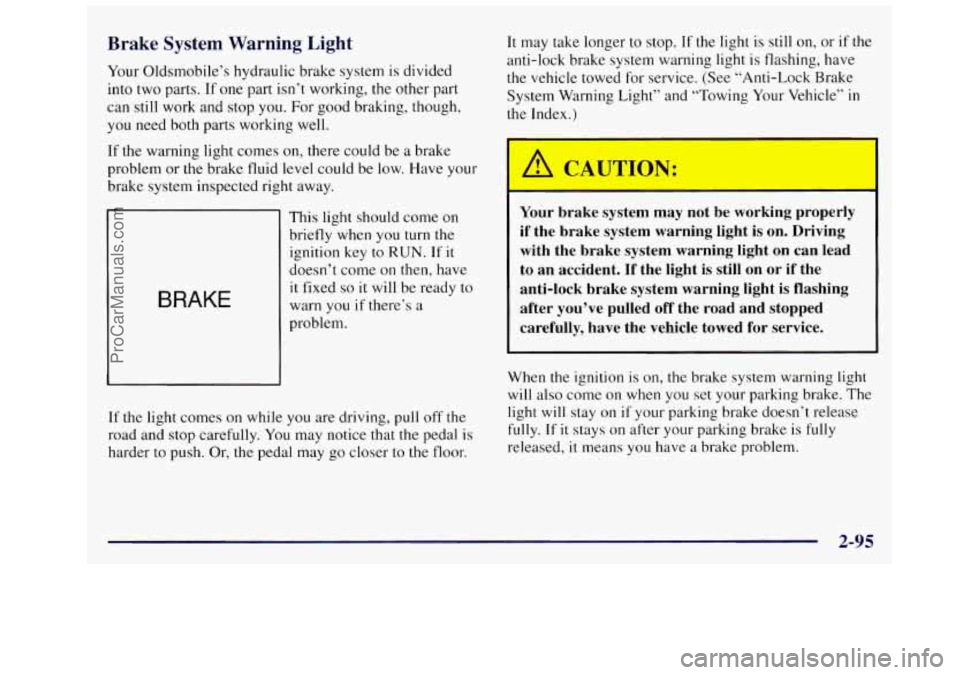
Brake System Warning Light
Your Oldsmobile’s hydraulic brake system is divided
into two parts. If
one part isn’t working, the other part
can still work and stop you. For good braking, though,
you need both parts working well.
If the warning light comes on, there could be a brake
problem or the brake fluid level could be low. Have your
brake system inspected right away.
BRAKE
This light should come on
briefly when you turn the
ignition
key to RUN. If it
doesn’t come on then, have
it fixed so it will be ready to
warn you
if there’s a
problem.
If the light comes
on while you are driving, pull off the
road and stop carefully. You may notice that the pedal
is
harder to push. Or, the pedal may go closer to the floor.
It may take longer to stop. If the light is still on, or if the
anti-lock brake system warning light is flashing, have
the vehicle towed for service. (See “Anti-Lock Brake
System Warning Light” and “Towing Your Vehicle”
in
the Index.)
Your brake system may not be working properly
if the brake system warning light is on. Driving
with the brake system warning light on can lead
to an accident. If the light is still on or if the
anti-lock brake system warning light is flashing
after you’ve pulled
off the road and stopped
carefully, have the vehicle towed
for service.
. UTIO--:
4
When the ignition is on, the brake system warning light
will also come on when you set your parking brake. The
light
will stay on if your parking brake doesn’t release
fully. If it stays on after your parking brake is fully
released,
it means you have a brake problem.
2-95
ProCarManuals.com
Page 244 of 436
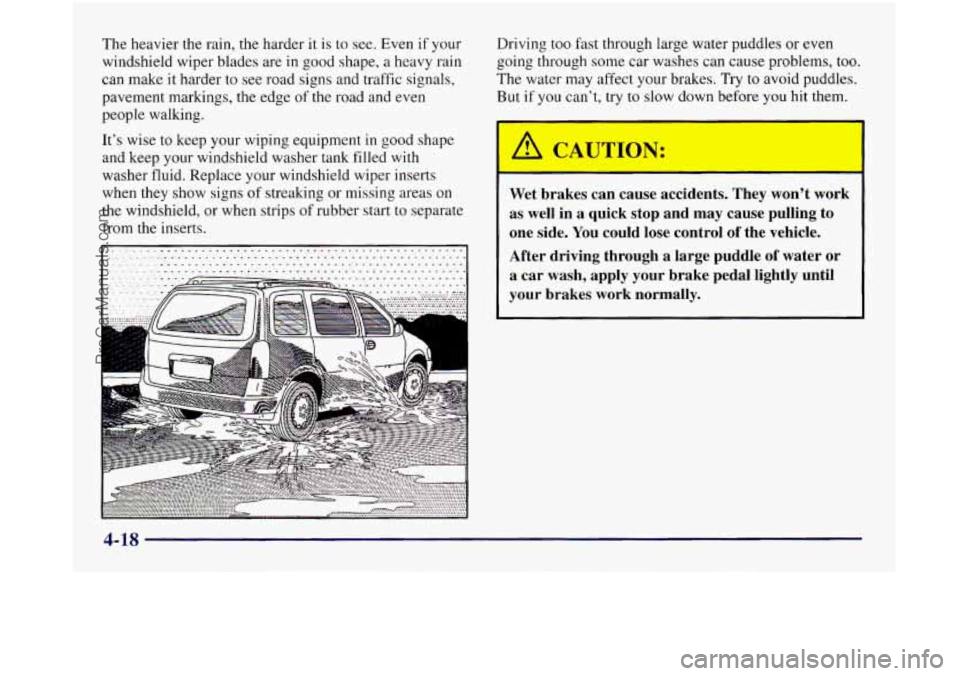
The heavier the rain, the harder it is to see. Even if your
windshield wiper blades are in good shape,
a heavy rain
can make
it harder to see road signs and traffic signals,
pavement markings, the edge
of the road and even
people walking.
It's wise
to keep your wiping equipment in good shape
and keep your windshield washer tank filled with
washer fluid. Replace your windshield wiper inserts
when they show signs of streaking or missing areas on
the windshield, or when strips
of rubber start to separate
from the inserts. Driving
too fast through large water puddles or
even
going through some car washes can cause problems, too.
The water may affect your brakes. Try to avoid puddles.
But
if you can't, try to slow down before you hit them.
Wet brakes can cause accidents. They won't work
as well in
a quick stop and may cause pulling to
one side. You could lose control of the vehicle.
After driving through
a large puddle of water or
a car wash, apply your brake pedal lightly until
your brakes work pormally.
4-18
ProCarManuals.com
Page 250 of 436
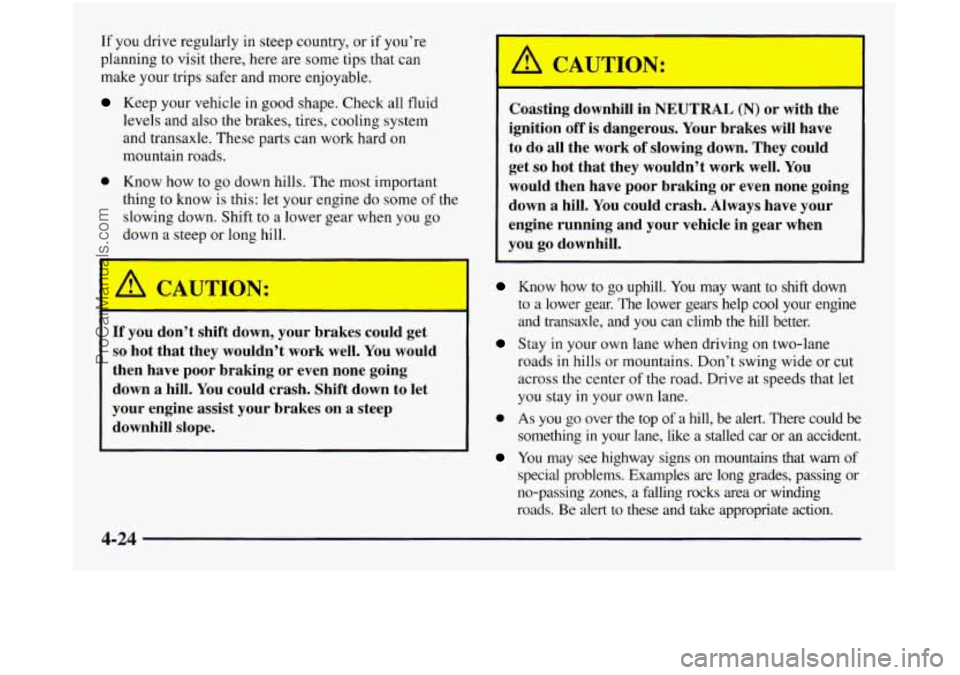
If you drive regularly in steep country, or if you’re
planning to visit there, here are some tips that can
make your trips safer and more enjoyable.
Keep your vehicle in good shape. Check all fluid
levels and also the brakes, tires, cooling system
and transaxle. These parts can work hard
on
mountain roads.
0 Know how to go down hills. The most important
thing to know is this:
let your engine do some of the
slowing down. Shift
to a lower gear when you go
down
a steep or long hill.
If you don’t shift down, your brakes could get
so hot that they wouldn’t work well. You would
then have poor braking or even none going
down
a hill. You could crash. Shift down to let
your engine assist your brakes on
a steep
downhill slope.
I A CAUTION:
~
Coasting d!!!nhill in NEUTRAL (N) or with the
ignition off is dangerous. Your brakes will have
to do all the work of slowing down. They could
get
so hot that they wouldn’t work well. You
would then have poor braking or even none going
down
a hill. You could crash. Always have your
engine running and your vehicle in gear when
you go downhill.
~
Know how to go uphill. You may want to shift down
to a lower gear. The lower gears help cool your engine
and transaxle, and you can climb the hill better.
Stay in your own lane when driving on two-lane
roads in hills or mountains. Don’t swing wide or cut
across
the center of the road. Drive at speeds that let
you stay
in your own lane.
0 As you go over the top of a hill, be alert. There could be
something in your lane, like
a stalled car or an accident.
You may see highway signs on mountains that warn of
special problems. Examples are long grades, passing or
no-passing zones, a falling rocks area or winding
roads.
Be alert to these and take appropriate action.
4-24
ProCarManuals.com
Page 264 of 436
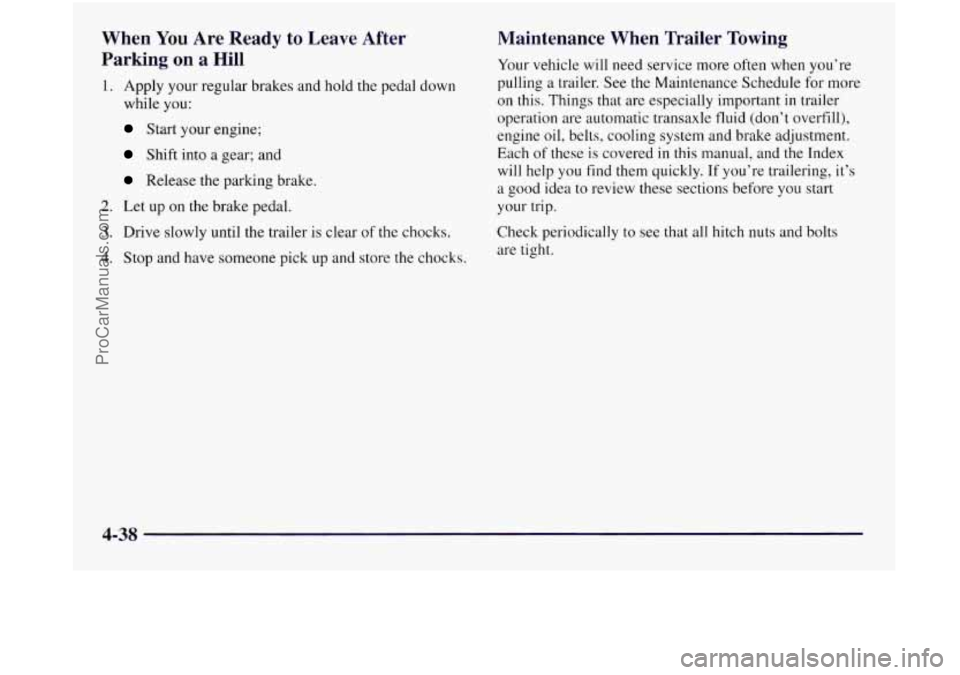
When You Are Ready to Leave After
Parking on
a Hill
1. Apply your regular brakes and hold the pedal down
while you:
Start your engine;
Shift into a gear; and
Release the parking brake.
2. Let up on the brake pedal.
3. Drive slowly until the trailer is clear of the chocks.
4. Stop and have someone pick up and store the chocks
Maintenance When Trailer Towing
Your vehicle will need service more often when you’re
pulling a trailer. See the Maintenance Schedule
for more
on this. Things that are especially important
in trailer
operation are automatic transaxle fluid (don’t overfill),
engine oil, belts, cooling system and brake adjustment.
Each
of these is covered in this manual, and the Index
will help you find them quickly. If you’re trailering, it’s
a good idea to review these sections before you start
your trip.
Check periodically to
see that all hitch nuts and bolts
are tight.
4-38
ProCarManuals.com
Page 273 of 436
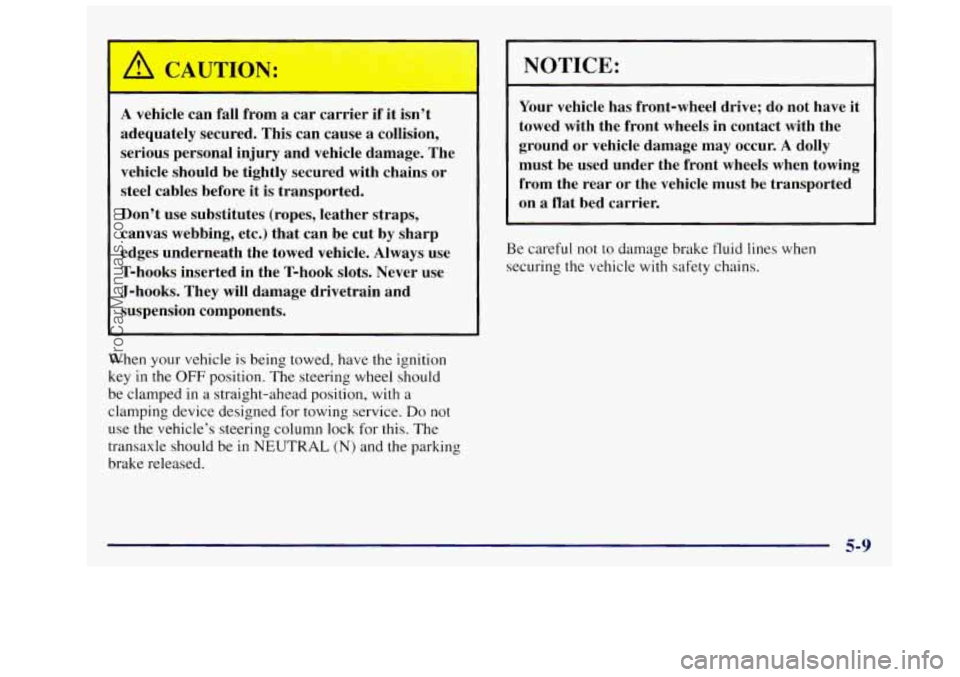
A vehicle can fall from a car carrier if it isn’t
adequately secured. This can cause a collision,
serious personal injury and vehicle damage. The
vehicle should be tightly secured with chains or
steel cables before it
is transported.
Don’t use substitutes (ropes, leather straps,
canvas webbing, etc.) that can be cut by sharp
edges underneath the towed vehicle.
Always use
T-hooks inserted in the T-hook slots. Never use
J-hooks. They will damage drivetrain and
suspension components.
When
your vehicle is being towed, have the ignition
key in the OFF position. The steering wheel should
be clamped in
a straight-ahead position, with a
clamping device designed for towing service.
Do not
use
the vehicle’s steering column lock for this. The
transaxle should be in
NEUTRAL (N) and the parking
brake released.
NOTICE:
Your vehicle has front-wheel drive; do not have it
towed with the front wheels in contact with the
ground or vehicle damage may occur.
A dolly
must be used under the front wheels when towing
from the rear or the vehicle must be transported
on a flat bed carrier.
Be careful not to damage brake fluid lines when
securing the vehicle
with safety chains.
5-9
ProCarManuals.com
Page 299 of 436
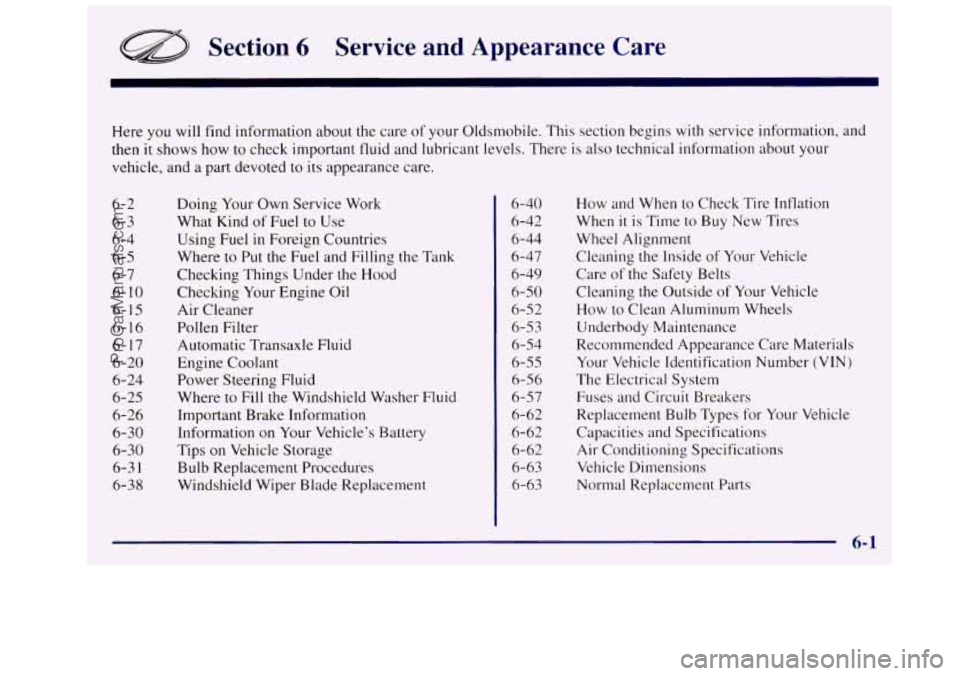
Section 6 Service and Appearance Care
Here you will find information about the care of your Oldsmobile. This section begins with service information, and
then it shows how to check important fluid and lubricant levels. There is also technical information about your
vehicle, and a part devoted
to its appearance care.
6-2
6- 3
6-4
6-5
6-7
6-10 6-15
6-16 6-17
6-20 6- 24
6-25
6-26
6-30 6-30
6-3
1
6-38 Doing
Your Own Service Work
What Kind
of Fuel to Use
Using Fuel in Foreign Countries
Where to Put the Fuel and Filling the Tank
Checking Things Under the Hood
Checking Your Engine
Oil
Air Cleaner
Pollen Filter
Automatic Transaxle Fluid
Engine Coolant
Power Steering Fluid
Where to Fill
the Windshielc 9 Washer Fluic
Important Brake Information
Information on Your Vehicle’s Battery
Tips on Vehicle Storage
Bulb Replacement Procedures
Windshield Wiper Blade Replacement 6-40
6-42
6-44
6-47 6-49
6-50
6-52
6-53 6-54
6-55 6-56
6-57
6-62
6-62
6-62 6-63
6-63 How and
When to Check Tire Inflation
When
it is Time to Buy New Tires
Wheel Alignment
Cleaning the Inside of Your Vehicle
Care of the Safety Belts
Cleaning
the Outside of Your Vehicle
How to Clean Aluminum Wheels
Underbody Maintenance
Recommended Appearance Care Materials
Your Vehicle Identification Number
(VIN)
The Electrical System
Fuses and Circuit Breakers
Replacement Bulb Types for Your Vehicle
Capacities and Specifications
Air Conditioning Specifications
Vehicle Dimensions
Normal Replacement Parts
6-1
ProCarManuals.com
Page 305 of 436
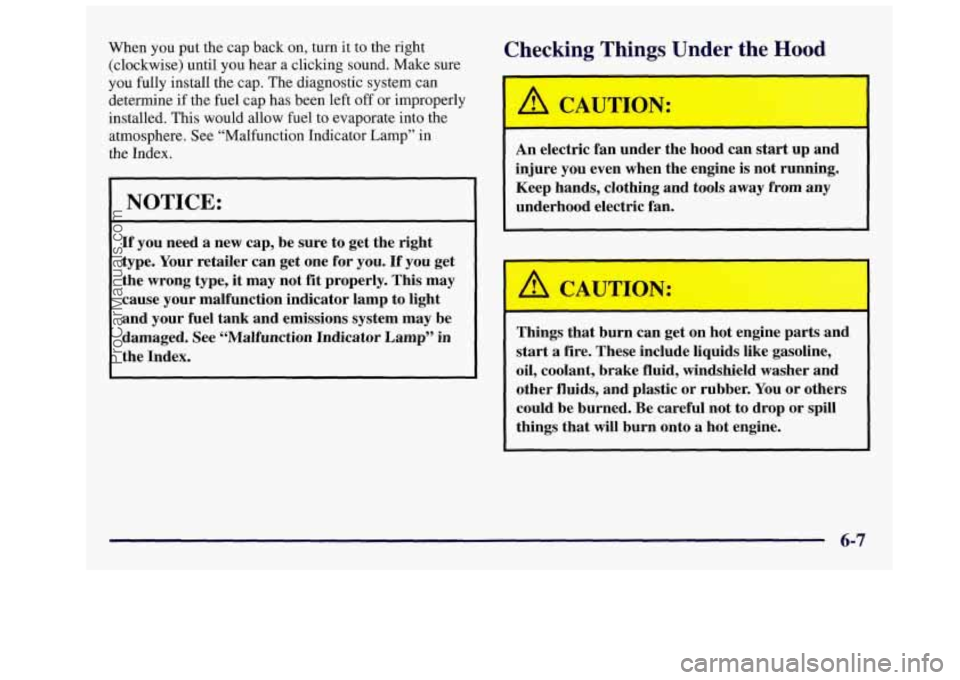
When you put the cap back on, turn it to the right
(clockwise) until you hear a clicking sound. Make sure
you fully install the cap. The diagnostic system can
determine if the fuel cap has been left
off or improperly
installed. Ths would allow
fuel to evaporate into the
atmosphere. See “Malfunction Indicator Lamp” in
the Index.
NOTICE:
If you need a new cap, be sure to get the right
type. Your retailer can get one for you.
If you get
the wrong type,
it may not fit properly. This may
cause your malfunction indicator lamp to light
and your fuel tank and emissions system may be
damaged. See “Malfunction Indicator Lamp” in
the Index.
Checking Things Under the Hood
An electric fan under the hood can start up and
injure you even when the engine is not running.
Keep hands, clothing and tools away from any
underhood electric fan.
1
Things that burn can get on hot engine parts and
start a fire. These include liquids like gasoline,
oil, coolant, brake fluid, windshield washer and
other fluids, and plastic or rubber.
You or others
could be burned. Be careful not to drop or spill
things that will burn onto a hot engine.
6-7
ProCarManuals.com
Page 307 of 436
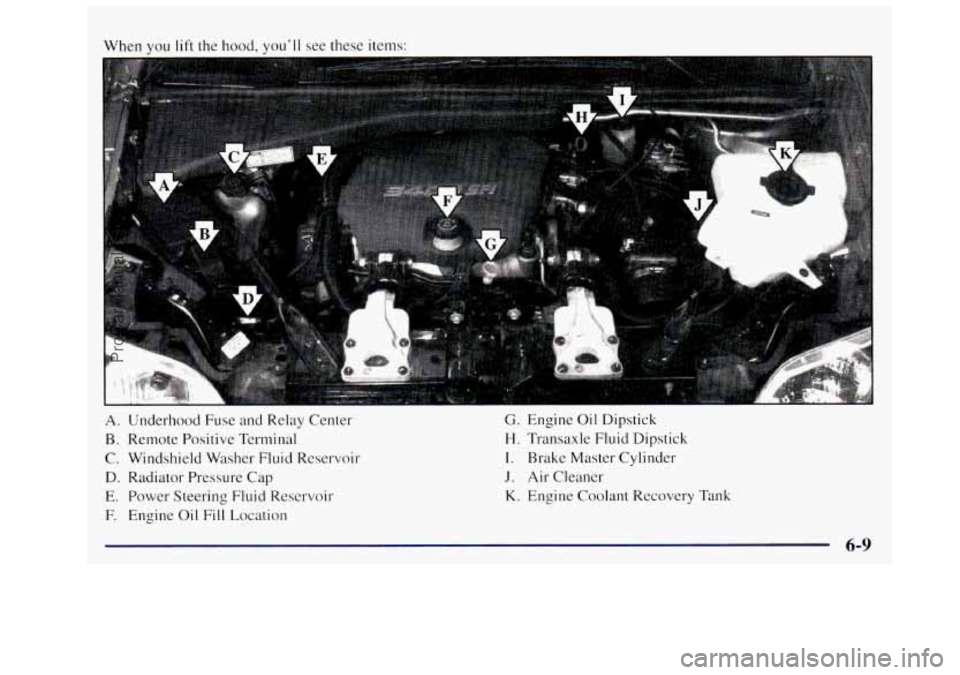
Nhen you lift the hood, you’ll see these items:
A. Underhood Fuse and Relay Center
B. Remote Positive Terminal
C. Windshield Washer Fluid Reservoir
D. Radiator Pressure Cap
E. Power Steering Fluid Reservoir
F. Engine Oil Fill Location
G. Engine Oil Dipstick
H. Transaxle Fluid Dipstick
I. Brake Master Cylinder
J. Air Cleancr
K. Engine Coolant Recovery Tank
6-9
ProCarManuals.com